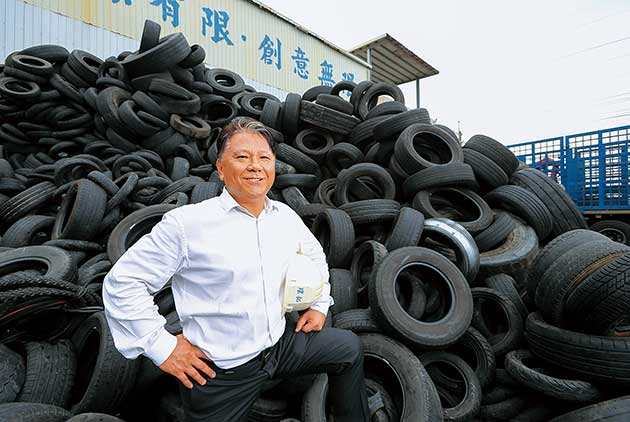Enrestec
Spinning Waste into New Tires Raises Global Interest

Source:CW
Pile after pile of waste tires stacked in small mountains comprise a “Taiwanese landscape” that Enrestec is determined to eliminate. The company’s turning junk tires into new tires and toner cartridges has attracted global attention.
Views
Spinning Waste into New Tires Raises Global Interest
By Kwangyin LiuFrom CommonWealth Magazine (vol. 607 )
Why have mountains of discarded tires have piled up all around Taiwan in recent years?
In 1989, the Environmental Protection Agency (EPA) promoted the recycling of scrapped tires, taking back over 100,000 tons of waste tires. Of these, following crushing, 60 percent of the waste tires were provided to four enterprises, including Yuen Foong Yu Group and Taiwan Cogeneration Corp., as supplementary fuel. However, as burned tires produce five times the amount of sulfur oxides than bituminous coal, manufacturers have greatly reduced their use in recent years due to air pollution concerns. This has resulted in an oversupply of discarded tires.
What has become of the remaining waste tires? Beyond being repurposed as roadside bumpers, 25 percent can be completely broken down and put back into the production chain. The “secret base” where this all happens is Enrestec’s facility in Fangliao, Pingtung County.
Toppling Waste Tire Mountains
Enrestec chief executive Michael Yuan’s departure from the construction field a dozen years ago to dive into waste tires business was a complete surprise. He was a close acquaintance of Kao Hsing Chang Iron & Steel Corp. CEO Lu Tai Jung, whose father had purchased waste tire recycling equipment from Switzerland but was unable to get the business off the ground. In Yuan’s words, “You have to get right back up where you fell down,” and they started over in the Pingnan Industrial Zone.
What is difficult about waste tire recycling? Shredding the tires and separating the rubber from the steel is the easiest step; the hard part is pyrolysis technology to separate carbon black (the raw material used to produce black rubber) and pyrolysis oil (similar to fuel oil); beyond that, the difficulty is finding buyers for recycled products.
“Over a dozen plants in Taiwan were interested in doing it (offering waste tire recycling), but they couldn’t find buyers for carbon black,” as Enrestec president Wu Chun-yao relates, either it was marred by foul-smelling impurities, or companies lost interest and shrunk away upon hearing the term “recycled.”
At Enrestec, waste tires are nearly 100-percent recycled, broken down as 38 percent pyrolysis oil, 28 percent carbon black, 15 percent steel belts, and 19 percent combustible gas. Enrestec’s carbon black is odorless and can be re-used in tires, ink, and toner cartridges. The company counts Kenda Tire and Hwa Fong Rubber among its customers, and a major American tire manufacturer dispatched engineers to conduct over a year of testing in Taiwan. Enrestec sells recycled carbon black to China, Vietnam and Thailand, currently exceeding an annual volume of 300 tons.
Recycled black carbon can reduce carbon output. The production of one ton of carbon black requires two tons of crude. With annual global demand for carbon black approximately 20 million tons at present, a switch to recycled carbon black could potentially save 40 million tons of crude.
Enrestec’s production process exemplifies the circular economy at work. The oil and gas produced by pyrolysis can be added to engines in place of diesel, or re-circulated for turbo combustion to significantly reduce fuel and exhaust. Enrestec even sells steam to a nearby petrochemical plant, helping to save NT$6 million in fuel costs per year.
However, with company capitalization rising from tens of millions NT dollars to over NT$800 million, Enrestec has not made a profit in 12 years. Michael Yuan relates that his company spends over NT$30 million on R&D personnel alone each year.
What makes Enrestec willing to pump so much money into research and development? “Waste tires are a worldwide problem we’re sure we can resolve,” asserts Lu Tai Jung, the company’s number-two shareholder, adding “If you’re going to do something, success is not an option.”
With Taiwan, China and U.S. patents in hand, only U.S.-based Reklaim and German outfit Pyrolyx can approach Enrestec. However, the latter two firms only operate demonstration plants at this time, falling well short of Enrestec’s capacity for continuous production.
Still, legal regulations unfriendly to the circular economy continue to cause them headaches.
Restrictive Regulations Force Detours
The NT$3 per kilogram subsidy for waste tires offered by the Environmental Protection Administration (EPA) is available only after receiving the materials, shredding, and clearance. Michael Yuan relates that most waste tire treatment operators collect their subsidies after completing the first half of the process and the rubber is hauled away and incinerated.
But Enrestec wants to turn waste into raw material. In order to conform with regulations, the company must haul shredded tires away from the shredding plant, then re-enter the pyrolysis facility at the same plant for offloading.
“Using conveyor belts to transport shredded tires to the pyrolysis facility could save a million NT dollars in personnel and fuel costs each year and cut out unnecessary steps,” he says.
In addition, businesses must adjust their attitudes towards recycled products moving forward. Wu Chun-yao relates one foreign car mat maker’s delight at learning about Enrestec’s recycled carbon black. “Their customer demanded mats made from 100 percent recycled materials, and after finding us, their frustration came to an end,” he says. In contrast, however, Taiwanese firms are lukewarm. “Products made from partially or fully recycled materials have a great future given European and American consumers’ attention to the environment,” he says.
With 30 million tons of waste tires produced worldwide every year, Enrestec looks to spread its technical knowhow around the globe. Although that day still looms far in the distance, this group of optimistic dreamers will surely never give up in pursuit of their goals.
Translated from the Chinese by David Toman






